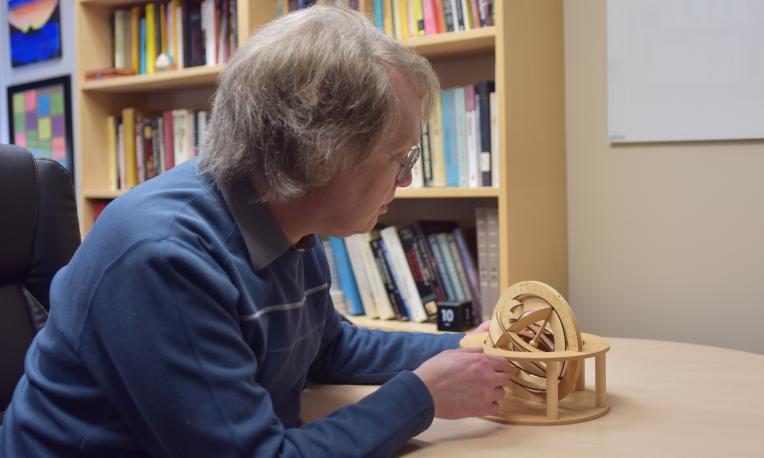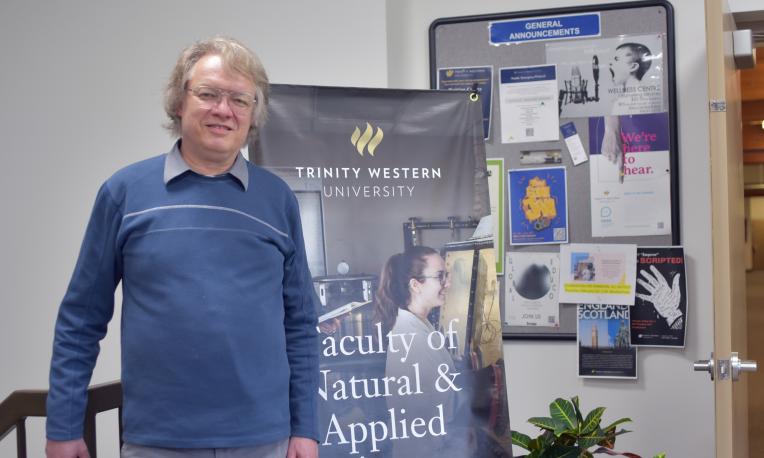Trinity Western professor Dr. Glen Van Brummelen has long been fascinated by mathematics and trigonometry, subjects with rich histories that are surprisingly interdisciplinary and global.
As a mathematics historian and professor, he has discovered a surprising fact about the origins of the decimal point.
A surprising discovery
While researching late medieval and early Renaissance astronomy, Dr. Van Brummelen, who is dean of the Faculty of Natural and Applied Sciences, noticed an unexpected usage of a decimal point in a sine table.
While most mathematicians have thought that German Jesuit astronomer Christopher Clavius was the first to use the decimal point within a table showing triangular ratios in 1593, Dr. Van Brummelen has discovered that Giovanni Bianchini, an Italian court astrologer, used the decimal point a century prior.
This earlier dating of the decimal point reveals the richness of medieval scientific activity, dispelling the popular notion that the medieval era was a time of intellectual stagnation.
While most mathematicians have thought that German Jesuit astronomer Christopher Clavius was the first to use the decimal point ...Dr. Van Brummelen has discovered that Giovanni Bianchini, an Italian court astrologer, used the decimal point a century prior.

Groundbreaking research
Dr. Van Brummelen’s finding, captured in a recently published journal article in Historia Mathematica, describes his discovery and credits Bianchini for this novel use of the decimal point.
Although many different civilizations throughout history, including ancient Arabic and Asian cultures, have also invented decimal fractional notation, those earlier forms of notation did not persist until current day. Bianchini and Clavius were instrumental in establishing the modern decimal notation and setting it on its way to eventually become the dominant system worldwide. We now know that Bianchini’s use of the decimal point preceded Clavius by 150 years.
“Mathematics doesn’t develop on its own as people often think of it, but rather, in response to situations that arose in other scientific contexts or even in the trades or finance.”
Math developing across borders and disciplines
The global history of the decimal point from ancient times shows that many societal factors contribute to the development of a mathematical system.
As Dr. Van Brummelen observes, “Mathematics doesn’t develop on its own as people often think of it, but rather, in response to situations that arose in other scientific contexts or even in the trades or finance.” Bianchini, for example, while being a professor of mathematics and astronomy at the University of Ferrara and the court astrologer for Leonello d'Este, was also employed by members of the d’Este court to help manage their business and trade practices.
The work of Bianchini and others have culminated in an internationally recognized system of notation that people around the world use every day. Dr. Van Brummelen comments on the importance of this universal decimal system, “We don’t often think of it today, but imagine doing science or commerce where different number systems are used by different people. Such different systems in weights and measures were one of the causes of the French Revolution, and a cause of the crash of the Mars Polar Lander in 1999.”

Advancing in education, research, and publication
In his other publications, Dr. Van Brummelen has written further about Bianchini’s mathematical theories that have changed history. Another of Bianchini’s contributions that we can see today is his invention of what became the tangent function in trigonometry, now a standard button on our calculators and a regular tool of science, engineering, and technology.
As an educator and author, Dr. Van Brummelen is especially keen on introducing others to the wonders of mathematics and trigonometry, particularly the disciplines’ non-Western varieties. He has thus far written four books, in addition to many articles and book chapters, covering the developments of math throughout India, China, and the Arab World, and how these Eastern discoveries intersect with the scientific discoveries of Europe and the Americas.
Recently he has been working as a member of the European Research Council-funded team ALFA (Alfonsine Astronomy), exploring the development of spherical astronomy in medieval and early Renaissance Europe and its links to Greek and Islamic predecessors. His research has uncovered the beginning of the modern tangent and arc sine functions, as well as the origin of our modern decimal numeration in the astronomical tables of the 15th century.
See also: Glen Van Brummelen's discovery featured in international media publications including Nature, Scientific American, National Geographic (Spanish edition), Newsweek, and NPR.
About Glen Robert Van Brummelen, PhD
Glen is a historian of mathematics and astronomy in ancient and medieval cultures, sometimes described as the only historian of trigonometry in the world. He is author of The Mathematics of the Heavens and the Earth: The Early History of Trigonometry (Princeton, 2009), Heavenly Mathematics: The Forgotten Art of Spherical Trigonometry (Princeton, 2017), Trigonometry: A Very Short Introduction (Oxford, 2020), and The Doctrine of Triangles: A History of Modern Trigonometry (Princeton, 2021). He has served twice as president of the Canadian Society for History and Philosophy of Mathematics. He won the Mathematical Association of America’s Haimo Award for Distinguished Teaching in 2016, and the 3M National Teaching Fellowship in 2017.
About the Faculty of Natural and Applied Sciences
At TWU, science education is delivered by capable, committed Christian educators who are not only experts in their fields but scholars who continually advance their disciplines through research. Mentorship is helped by our small class sizes—whether students choose to study biology, biotechnology, chemistry, computer science, geography and the environment, geology, mathematics, or physics. Learn more at the Faculty of Natural and Applied Sciences.
About Trinity Western University
Founded in 1962, Trinity Western University is a global Christian liberal arts university. We are dedicated to equipping students to discover meaningful connections between career, life, and the needs of the world. Drawing upon the riches of the Christian tradition, seeking to unite faith and reason through teaching and scholarship, Trinity Western University is a degree-granting research institution offering liberal arts and sciences as well as professional schools in business, nursing, education, human kinetics, graduate studies, and arts, media, and culture. It has campuses in Canada in Langley, Richmond, and Ottawa. Learn more at www.twu.ca or follow us on Instagram @trinitywestern, Twitter @TrinityWestern, on Facebook and LinkedIn.
For media inquiries, please contact: media@twu.ca.

